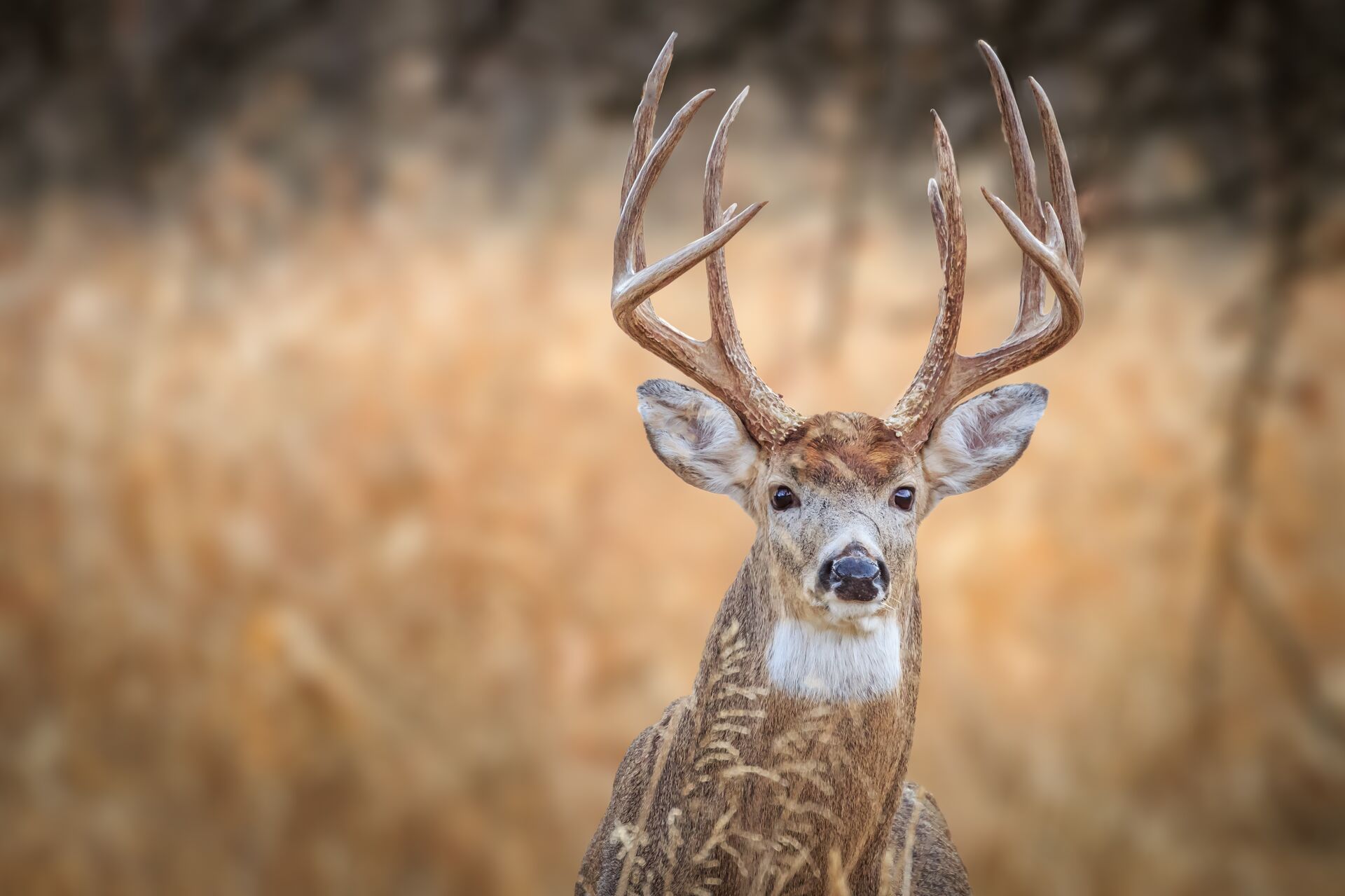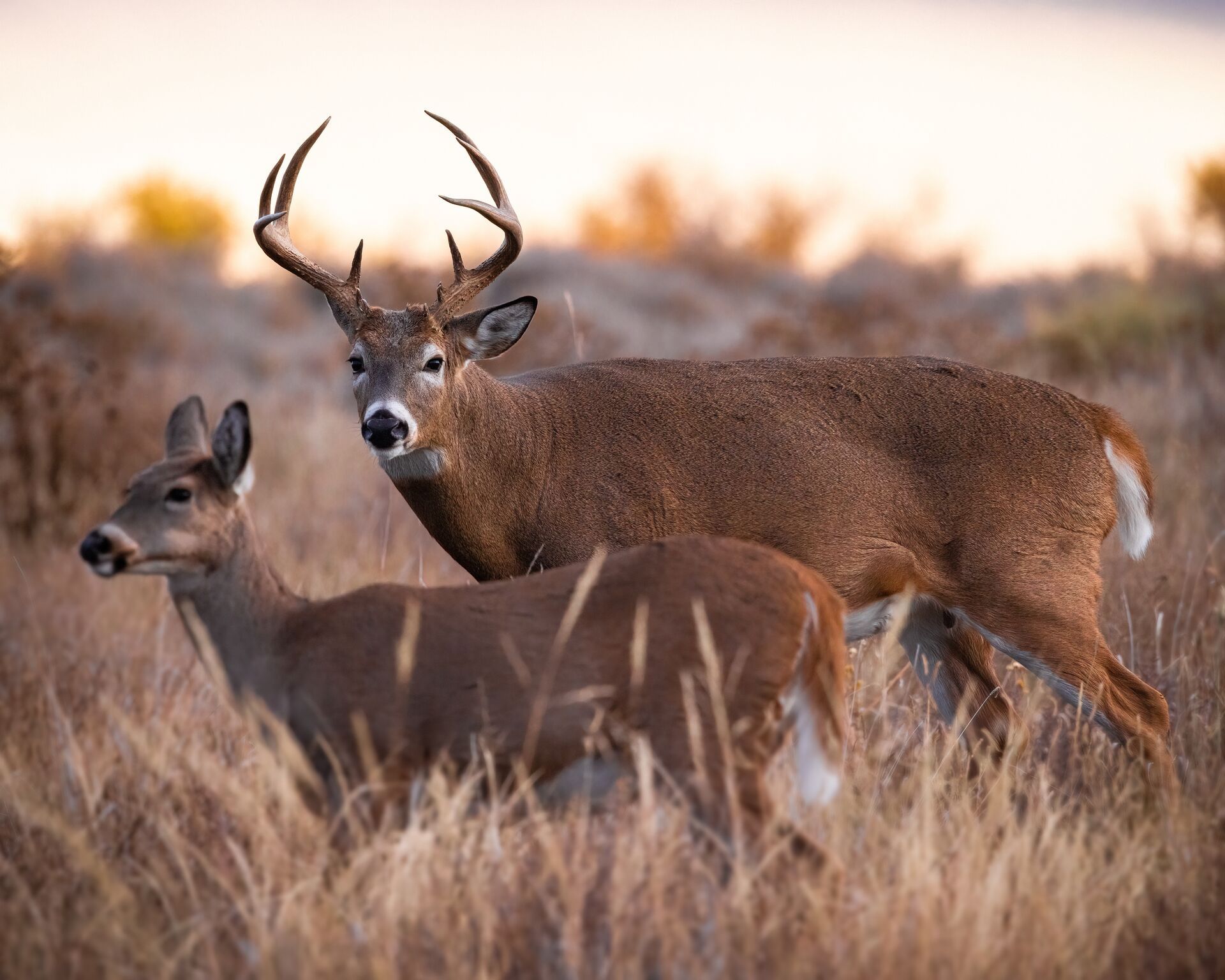Not only is correctly identifying your target the right thing to do, but misidentifying can get you in heaps of trouble with the law – even if you made an honest mistake.
Let’s talk about a critical thing every hunter needs to know heading into deer season: how to identify buck deer versus does to keep you on the right side of the rules and ensure a successful hunt.

Look for Antlers
Easily their most distinguishing feature, bucks over one and a half years old will have some form of noticeable antlers from mid-spring through winter.
However, yearling bucks, called button bucks, have antlers that may not break the surface of the skin. Antler size, number of points, and shape can vary with each animal’s age, genetics, and available nutrition.
Does generally do not grow antlers, though there are some documented rare exceptions due to injury or hormonal imbalances such as high testosterone levels. Those rare antlered does do not usually come out of velvet, and their racks are very small or stay as spikes.
Luckily for us hunters, most states have chosen to offer deer tags labeled as antlerless instead of doe.
Buck Deer Antlers Grow in the Spring
A buck deer’s testosterone level follows the photoperiod, or amount of sunlight in a day, of the season. In the spring, the increasing amount of daylight causes testosterone levels in bucks also to increase, spurring the growth of antlers.
As the amount of daylight decreases in the winter, so again do the bucks’ hormone levels. This decrease in testosterone normally causes bucks to shed their antlers in the winter. However, it can happen sooner due to stressful conditions such as harsh winter weather or declining nutrition available in deer’s home range.
Body Size and Shape
Late-season deer have typically lost a fair amount of weight, but even if a buck has already shed his antlers, he will still look like a buck.
Bucks are generally larger and more muscular than does, with a heavier build, a thicker neck, and broader shoulders. Does have a more slender and streamlined, almost rectangular build. Young button bucks will be a bit more squarish compared to does.
About the Face
Bucks that have recently shed their antlers will have a bloody hole just above the ears on the top of their head. That’s called the pedicle, where the antlers connect to the skull of the deer. That area scabs over quickly, though, but you can still determine the sex of the animal by its head shape.
Bucks often have a more pronounced, flattened forehead with larger, blockier heads. A doe’s head is typically more rounded on top with a narrower face, similar to the shape of an old-school glass Coke bottle with floppy ears.
Button bucks will have a shorter snout than a doe and still have a flattened forehead similar to a more mature buck.
The Neck and Chest
During the rut, a buck’s neck can swell by 50 percent. Even outside of the breeding season, their necks are thicker than those of does.
Does have a more elongated and graceful-looking neck. Button bucks will have a shorter neck. Buck deer will also have a larger and more pronounced brisket.
Look for the Tarsal Glands
All deer use their tarsal glands, the hairy tufts of fur on the inside of their hind legs, as a way of scent communication and identification. But bucks – especially big mature bucks – use them the most.
During the rut, bucks will “rub-urinate” on these glands more often. The tarsal gland’s surrounding hair absorbs and holds onto its oily secretions and urine, staining the tarsal a dark brown and making it more pronounced than the lighter and less noticeable glands of a doe or non-breeding button buck.
 Observe Their Behavior
Observe Their Behavior
How bucks and does behave can tell you a lot and help you identify them in the field.
Young button bucks will be less hesitant to walk into an open food plot than the rest of the herd. This is a result of the lack of experience with hunters or environmental predators.
However, adult deer will stand for a few moments to scan the area for danger before committing and frequently look up as a precaution, whereas young deer are just a bit more naive.
Does frequently travel together in family groups, where button bucks will likely travel alone or in pairs with another non-breeding subordinate buck. Late-season bucks will also typically travel solo.
After a physically taxing rut, breeder bucks need to pack on as many calories as possible during the colder post-rut period. Don’t be surprised if that late-season trophy-sized feeding by itself in the food plot at last light isn’t a doe at all. It could very well be a buck who has already shed his antlers.
How Can You Know for Sure?
Be patient.
It’s better to be safe than sorry, and you don’t want to think you are taking a doe for the freezer and instead accidentally harvest what could have been a future wall hanger.
Using your rifle scope or binoculars to view and positively identify your game can ensure you make the right choice. As a precaution and when possible, it can be a good idea to wait until there are several deer together. Then, you can pick out and harvest the largest antlerless deer in the group.
Use HuntWise to Fill Your Freezer This Season
Young button bucks or bucks who have already dropped their antlers can cause some confusion in the field when it comes to positively identifying your target. However, using the insights shared today, identifying body features and behavior can help you hunt ethically and stay on the right side of hunting regulations.
However, before you can observe deer during a hunt, you have to know where to find them! Using HuntCast in the HuntWise app can help you locate deer and choose the best days to hunt based on real-time animal behavior predictions. The mapping features help you identify good hunting areas and mark potential entry and exit points and other points of interest to scout land before getting into the field.
You can also use HuntWise during the off-season to track animal behavior. Use trail cams to observe deer year-round and note what you see in your HuntWise hunting app. Tracking a buck throughout the deer can help you identify him more easily from your stand or blind when you get out for your hunt.
As you prepare for deer season this year, make sure HuntWise is part of your gear. Download it for the first time and explore the app – free – for your first week!






![Air gun 101: The differences between .177 & .22 – Which jobs they do best ? [Infographic]](https://airgunmaniac.com/wp-content/uploads/2020/09/g44-218x150.jpg)






























 Observe Their Behavior
Observe Their Behavior




